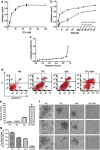Low-dose triptolide in combination with idarubicin induces apoptosis in AML leukemic stem-like KG1a cell line by modulation of the intrinsic and extrinsic factors
- PMID: 24309935
- PMCID: PMC3877540
- DOI: 10.1038/cddis.2013.467
Low-dose triptolide in combination with idarubicin induces apoptosis in AML leukemic stem-like KG1a cell line by modulation of the intrinsic and extrinsic factors
Abstract
Leukemia stem cells (LSCs) are considered to be the main reason for relapse and are also regarded as a major hurdle for the success of acute myeloid leukemia chemotherapy. Thus, new drugs targeting LSCs are urgently needed. Triptolide (TPL) is cytotoxic to LSCs. Low dose of TPL enhances the cytotoxicity of idarubicin (IDA) in LSCs. In this study, the ability of TPL to induce apoptosis in leukemic stem cell (LSC)-like cells derived from acute myeloid leukemia cell line KG1a was investigated. LSC-like cells sorted from KG1a were subjected to cell cycle analysis and different treatments, and then followed by in vitro methyl thiazole tetrazolium bromide cytotoxicity assay. The effects of different drug combinations on cell viability, intracellular reactive-oxygen species (ROS) activity, colony-forming ability and apoptotic status were also examined. Combination index-isobologram analysis indicates a synergistic effect between TPL and IDA, which inhibits the colony-forming ability of LSC-like cells and induces their apoptosis. We further investigated the expression of Nrf2, HIF-1α and their downstream target genes. LSC-like cells treated with both TPL and IDA have increased levels of ROS, decreased expression of Nrf2 and HIF-1α pathways. Our findings indicate that the synergistic cytotoxicity of TPL and IDA in LSCs-like cells may attribute to both induction of ROS and inhibition of the Nrf2 and HIF-1α pathways.
Figures






References
-
- Damiani D, Tiribelli M, Raspadori D, Michelutti A, Gozzetti A, Calistri E, et al. The role of MDR-related proteins in the prognosis of adult acute myeloid leukaemia (AML) with normal karyotype. Hematol Oncol. 2007;25:38–43. - PubMed
-
- Lapidot T, Grunberger T, Vormoor J, Estrov Z, Kollet O, Bunin N, et al. Identification of human juvenile chronic myelogenous leukemia stem cells capable of initiating the disease in primary and secondary SCID mice. Blood. 1996;88:2655–2664. - PubMed
-
- de Figueiredo-Pontes LL, Pintao MC, Oliveira LC, Dalmazzo LF, Jacomo RH, Garcia AB, et al. Determination of P-glycoprotein, MDR-related protein 1, breast cancer resistance protein, and lung-resistance protein expression in leukemic stem cells of acute myeloid leukemia. Cytometry B Clin Cytom. 2008;74:163–168. - PubMed
-
- Fardel O, Payen L, Courtois A, Drenou B, Fauchet R, Rault B. Differential expression and activity of P-glycoprotein and multidrug resistance-associated protein in CD34-positive KG1a leukemic cells. Int J Oncol. 1998;12:315–319. - PubMed
-
- She M, Niu X, Chen X, Li J, Zhou M, He Y, et al. Resistance of leukemic stem-like cells in AML cell line KG1a to natural killer cell-mediated cytotoxicity. Cancer Letters. 2012;318:173–179. - PubMed
Publication types
MeSH terms
Substances
LinkOut - more resources
Full Text Sources
Other Literature Sources

